The strategy for developing ports to attract cargo was traditionally based on designing infrastructure, offering efficient services or competing on the basis of prices. However, in the current environment this approach is not enough for ports to compete internationally, as they must operate sustainably while providing a clear value to society (Larissa et al., 2021). With this objective, ports aligned with Industry 4.0 trends have entered a new stage characterized by digitalization. Cooperation is a key element in this stage, encompassing not only groups exclusively related to the port itself, but extending to other stakeholders, such as the city, its hinterland, and all the way out to the global supply chain (De la Peña, 2020).
Furthermore, over the last decade, the European Commission (EC) has stressed the urgent need to decarbonize and improve the environmental performance of ports, as reflected in the European Union (EU)’s 20-20-20 goals, as well as in the Communications from the Commission COM 2013(295) “Ports: An engine for growth” and COM 2013(17) “Clean Power for Transport: A European alternative fuels strategy” and the EU White Paper setting out a roadmap to a competitive and efficient Single European Transport Area. The most recent movement in this direction has been the publication of the Fit for 55 package in July 2021, including the Alternative Fuels Infrastructure and FuelEU Maritime regulations.
In terms of the level of digitalization of its processes and the sustainability of its operations, the Port of Valencia starts out from a strong position compared to its surrounding ports, standing as a reference for many other ports around the world. Indeed, as a “Smart Port”, the Port of Valencia heads the ranking of Spanish ports from an economic, social, institutional and environmental perspective, as well as for its degree of digitalization (Rodrigo et al., 2020).
There are many examples that demonstrate the Port of Valencia’s commitment to and strategy for digitalization, sustainability and integration with the city. In particular, this article presents two examples of projects aimed at addressing the challenges set out by ECLAC (Doerr, 2016): specifically, port-city integration and environmental performance through digitalization and innovation. These projects foster the interconnection of digital smart port platforms with city platforms (smart city-ports).
Digitalization as a tool for environmental sustainability: Green C Ports Project
Green C Ports [1] is a project co-financed by the European Union through the Connecting Europe Facility programme. The aim of the project is to use a set of digitalization tools and technologies that will help boost ports’ connectivity and integration with cities, ensure their environmental sustainability, and optimize the environmental performance of port operations in the Trans-European Transport Network, TEN-T.
This initiative includes four case studies that will be carried out in the Port of Valencia. The first of these seeks to combine different sources of information such as port access systems, the Port Community System [2] and smart cameras in order to reduce road traffic congestion within the port area. In this respect, a series of prediction models are being designed that will estimate the number of trucks entering and leaving the port, making it possible to estimate future congestion levels. The next two case studies aim to improve air quality and reduce noise in the port by deploying a series of sensors, meteorological stations, a spectroscope and other equipment, in order to rapidly detect measurements above acceptable levels and inform the port authorities accordingly. Finally, the last case study focuses on measuring real-time emissions on door to door supply chains between the Valencian region and the Balearic Islands, in order to accurately determine the carbon footprint generated by a given shipment of goods.
To this end, the network of environmental and meteorological sensors in the Port of Valencia has been expanded, with the installation of 7 air quality sensors, 2 environmental monitoring stations, 3 sound level meters, 8 smart cameras for measuring traffic, and an infrared remote sensor to detect the emissions generated by ships moored in the port. In addition, some ships and vehicles have been equipped with continuous emission monitoring systems that will help to calculate the carbon footprint associated with the door to door logistics chain.
This network of sensors (see the following image) is connected to a port environmental platform, where the data captured will be modelled. In the Port of Valencia, the Osisoft PI System (OSIsoft, 2016) has been chosen as the tool to develop the environmental platform for this project. The PI System is a set of software products used for the collection, analysis, delivery and visualization of data collected by the network of sensors.
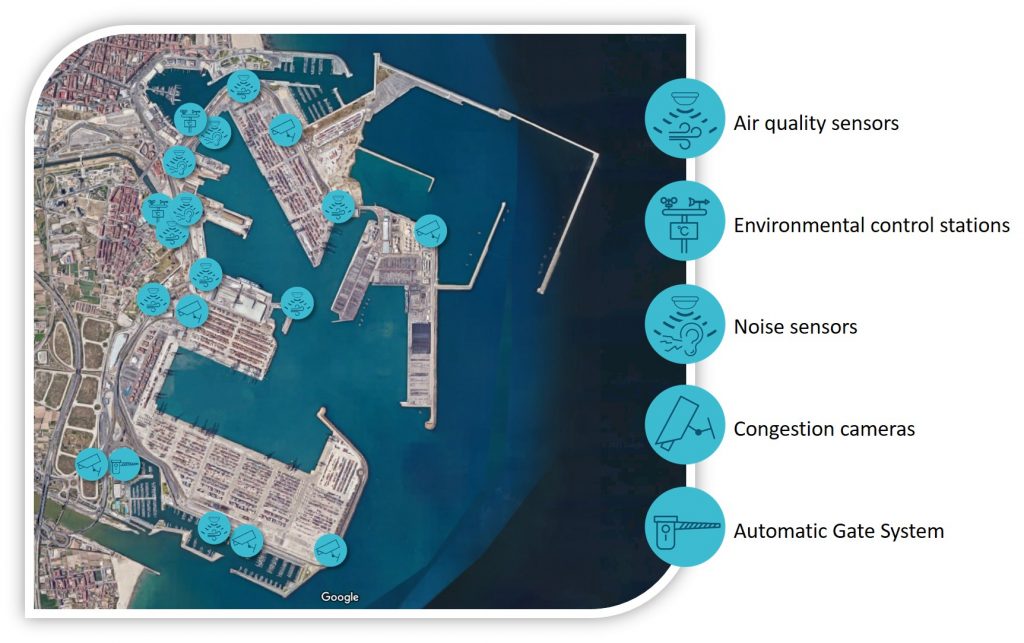
In the following image, shows the architecture of the solution adopted in the project to achieve the objectives set in the case studies. With the help of the PI tool, the environmental platform has been configured to create digital twins of all the systems and devices in the sensor network, as well as the different connections that allow the reception and storage of all the data. These data are used to create a history for modelling artificial intelligence algorithms that will provide a snapshot of the port’s situation in terms of congestion, air quality and noise in the short and medium term. Thanks to the set of control panels and web services deployed in the last layer, users can be informed about different key environmental parameters related to congestion levels, air quality, noise and emissions generated by port activities. Through the web services, this information will be shared with the other users outside the port, mainly with the city. To that end, this port platform will be integrated with the different Smart City platforms.
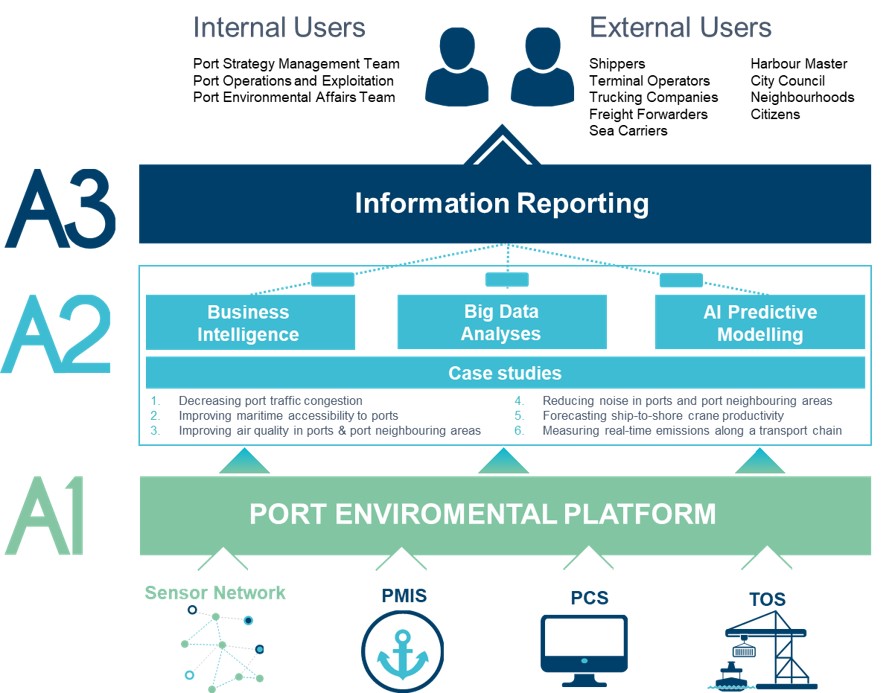
This project will contribute to reducing the impact of port operations on the city, control emissions from the port and ships, optimize cargo handling and facilitate the entry and exit of cargo into and out of the port.
Monitoring the flow of cruise passengers: the HERIT-DATA project
The city of Valencia is an undeniable tourist draw: more than two million people visited the city in 2019 before the outbreak of COVID. Likewise, the interest from cruise passengers has also grown, with an increase of more than 125% in the number of cruise passengers arriving at the Port of Valencia (a total of more than 435,000 in 2019).
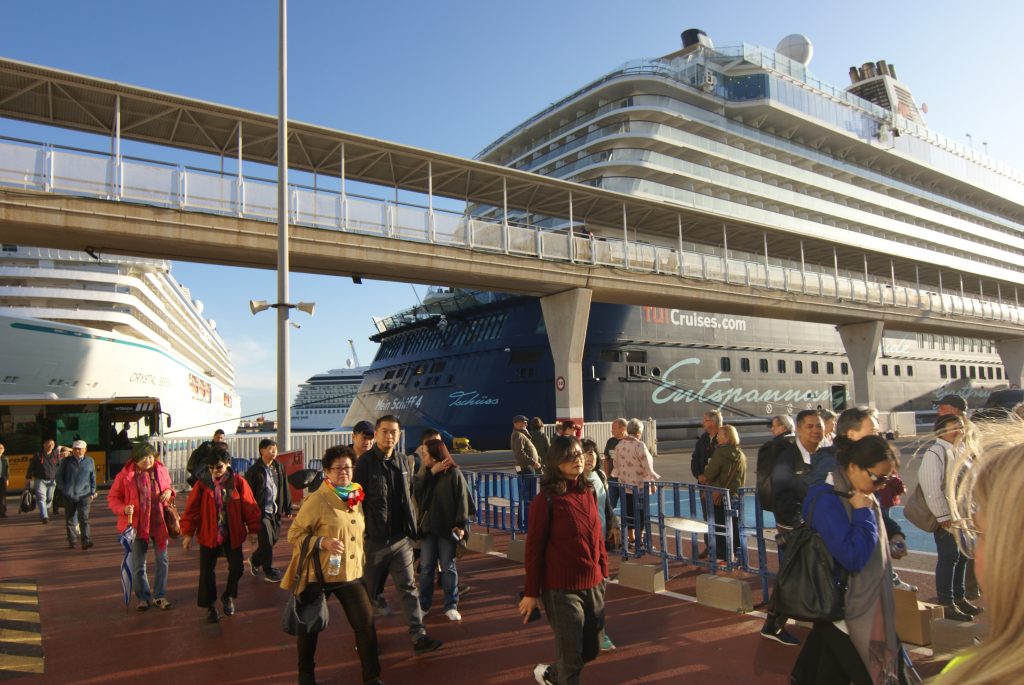
In order to improve the monitoring and management of cruise passenger flows in strategic areas of the city, Fundación Valenciaport is leading a pilot initiative as part of the HERIT-DATA project [3] funded by Interreg Mediterranean. The pilot includes three phases of implementation: data capture, data processing for the detection of cruise passengers, and developing the visualization of information on tourist flows in the city.
To carry out the first phase, a cruise management platform has been developed with the collaboration of the Port Authority of Valencia. This platform allows shipping companies to manage reservations for future cruise ship calls via a web interface. In addition, tour operators can keep authorities informed by registering the excursions organized for the cruise passengers arriving on each of the previously registered cruises. This information is critical for determining future flows of cruise passengers who will arrive in the city. Furthermore, in order to monitor the flow of cruise tourists in the city, it is necessary to track the real-time location of these tourists in certain points of interest in the city. To that end, a series of people-counting sensors have been installed in different strategic locations (see the following images).
These sensors, which use LoRa [4] and NB-IoT [5] technology, act as WiFi routers to detect tourists’ phones and assign them a unique identifier that, once encrypted, is stored and sent to the middleware platform for processing.
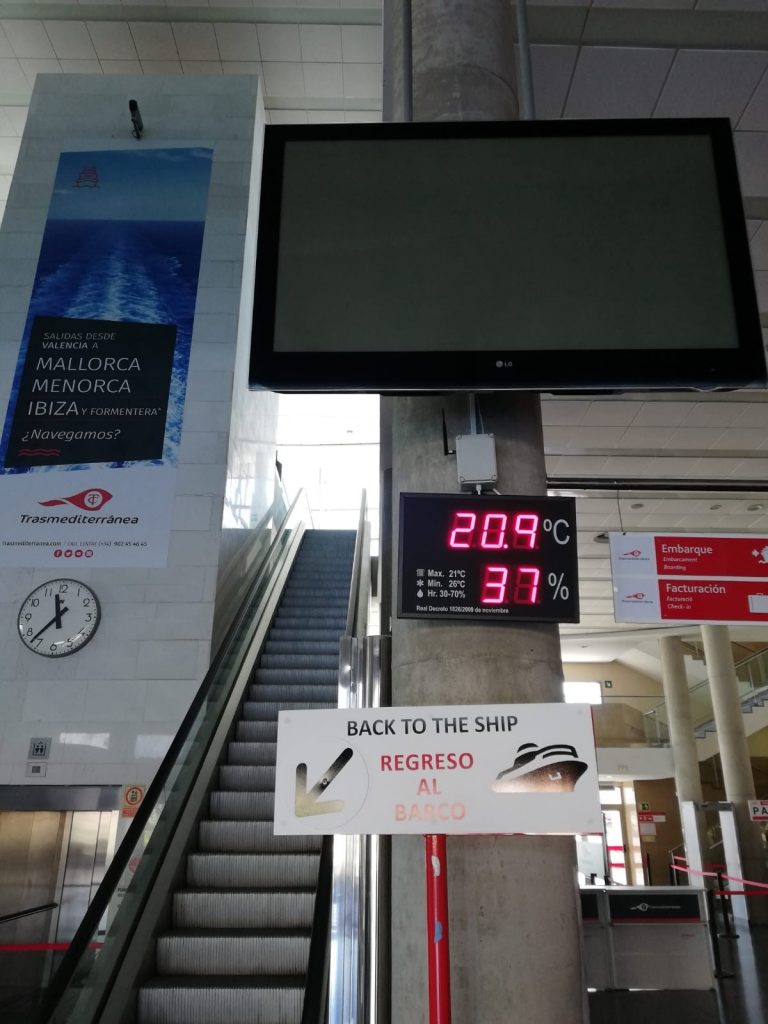
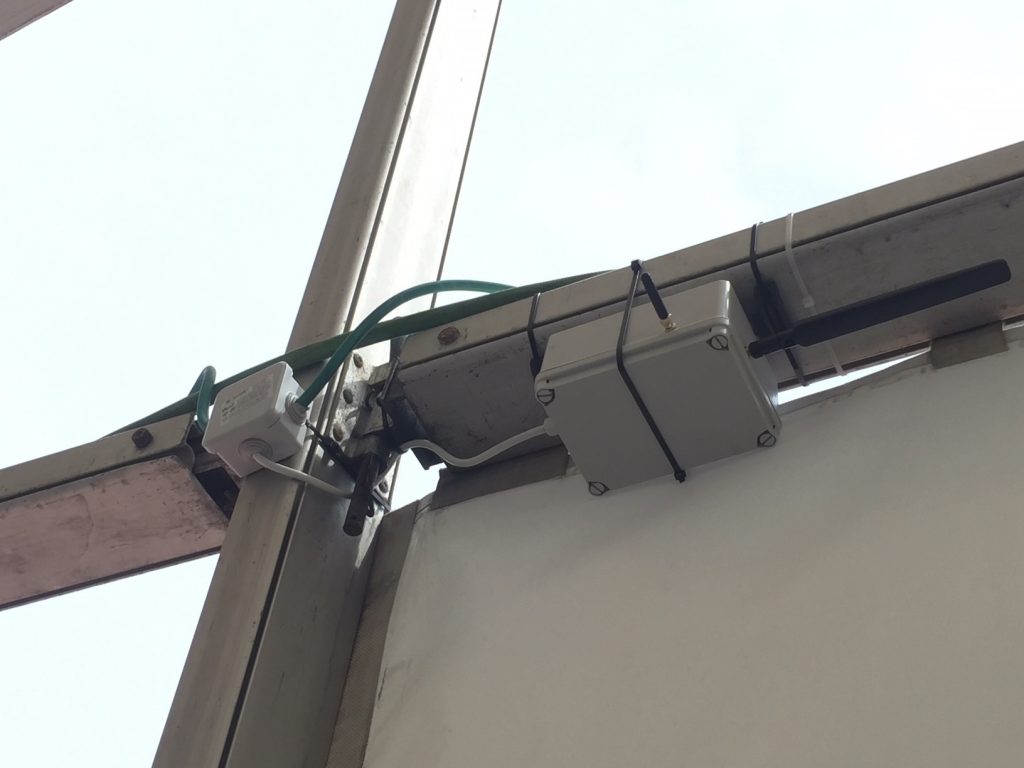
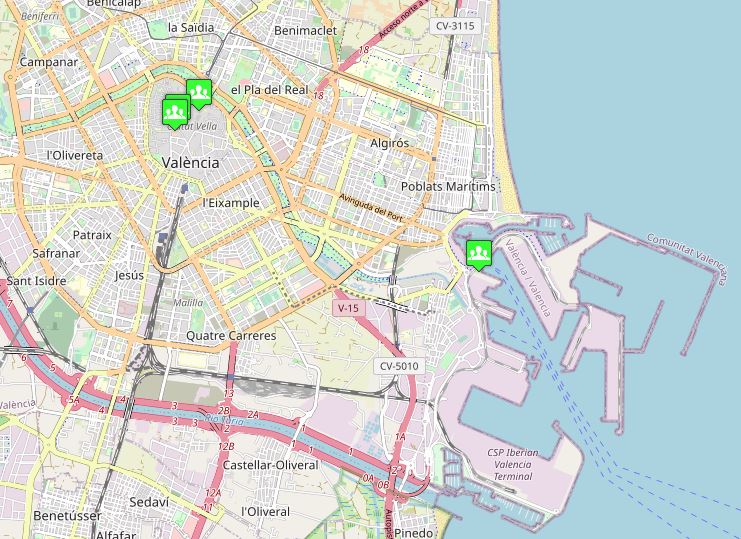
In the second phase, a middleware platform has been developed that receives these data and uses them to broadly distinguish between cruise passengers, residents and other tourists. To do so, this platform, developed in Node-Red [6], performs four operations in parallel: a) taking periodic readings of the number of people to estimate the flow at the measurement points, b) taking readings of regular mobile users at the cruise terminal, c) temporary registration of cruise passengers on cruise days, d) detection of cruise passenger mobile users at points in the city.
As the culmination of the processes of taking flow readings (a) and detecting cruise passengers in the city (d), these metrics are sent to the Snap4City platform, a multifunctional Internet of Things tool that enables tasks such as the management of Smart Cities through the storage, processing and visualization of data in real time (Badii et al., 2018).
In the following image, shows the end-to-end architecture of the solution implemented in Valencia.
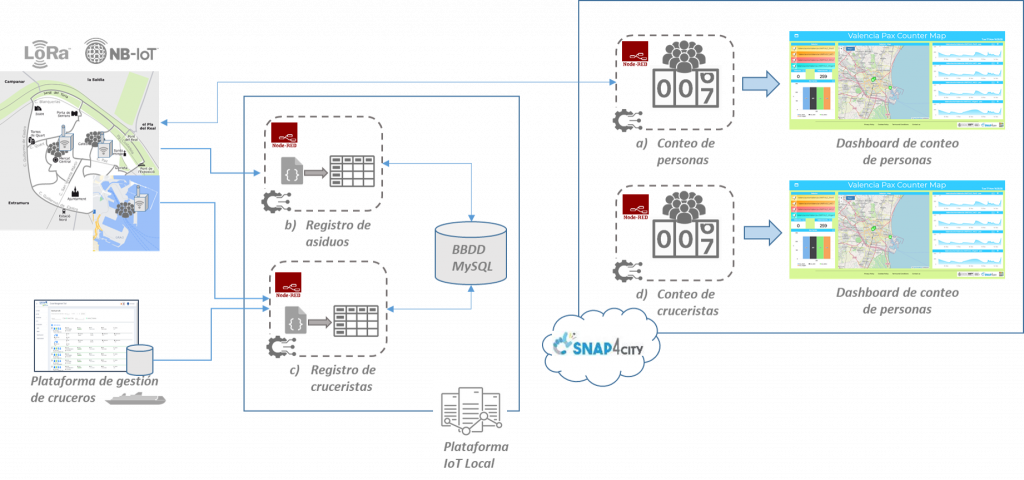
In the above architecture, the process of registrating regular users (b) involves taking a reading every 5 minutes of the identifiers of the mobile phones detected in that period by the sensor located in the port, and storing them in the MySQL database [7]. This is done on days without a cruise, thus making it possible to differentiate cruise passengers from regulars when a cruise calls at Valencia. To find out whether a cruise call is expected, this process also consults the database of the cruise management platform. At the same time, the aim of the process of registering cruise passengers (c) is to temporarily store in the MySQL database the cruise passengers that are disembarking, and thus be able to detect them in the other sensors of the city through the cruise passenger counting process (d). Lastly, the people-counting process (a) uses data from the city and port sensors to estimate the flow of people at the measurement points.
Thus, the benefits provided by the pilot initiative developed in Valencia include the following: real-time knowledge and reporting of the number of people in the tourist spots of the city; knowledge of the behaviour of cruise passenger flows in the city in order to implement measures to improve their experience of the visit; knowledge of the percentage of cruise passengers relative to other visitors at the measurement points; and knowledge of the share of cruises in mass tourism.
Future work includes the expansion of the sensor network in other points of the city and the measurement of additional parameters related to the impact of mass tourism, such as the use of sentiment analysis techniques through social networks to measure the possible dissatisfaction of tourists and residents in the measurement area. In addition, the use of artificial intelligence will be explored to predict possible overcrowding in tourist spots, as a support for decision-making aimed at mitigating the impact generated.
Head Image | Port of Valencia. (© Francisco Montesinos, 2019).
Notes
[1] https://greencportsproject.eu/
[2] Valenciaport (2021), A solution for the entire port community, https://www.valenciaportpcs.com/
[3] https://herit-data.interreg-med.eu/
[4] LoRa Alliance, https://lora-alliance.org/
[5] Narrowband – Internet of Things (NB-IoT), https://www.gsma.com/iot/narrow-band-internet-of-things-nb-iot/
[6] OpenJS Foundation, Node-Red: Low-code programming for event-driven applications, https://nodered.org/
[7] Oracle Corporation (2021), MySQL 8.0: Reference Manual, https://downloads.mysql.com/docs/refman-8.0-en.pdf
References
Badii C. et al (2018), Snap4City: A Scalable IOT/IOE Platform for Developing Smart City Applications, 2018 IEEE SmartWorld/SCALCOM/UIC/ATC/CBDCom/IOP/SCI, Guangzhou, China.
De la Peña Zarzuelo, I. & María Jesús Freire Soeane, M.J., & López Bermúdez, B. “Industry 4.0 in the port and maritime industry: A literature review, Journal of Industrial Information Integration”, Volume 20, 2020, 100173, ISSN 2452-414X.
Doerr, O. (2016), Modelos de Gestión y Gobernanza Portuaria: Desafíos actuales y el futuro de los puertos en LAC, CEPAL – Naciones Unidas.
European Commission (2013), Clean Power for Transport: A European alternative fuels strategy, Communication From The Commission To The European Parliament, The Council, The European Economic And Social Committee And The Committee Of The Regions, COM (2013) 17, Brussels.
European Commission (2013), Ports: an engine for growth, Communication From The Commission COM(2013) 295, Brussels.
European Commission (2011), Roadmap to a Single European Transport Area – Towards a competitive and resource efficient transport system, White Paper COM(2011) 144, Brussels.
Larissa, Drs & Van, M & van der Lugt, Larissa & Peter, Dr & Langen, Peter. (2021). Port Authority Strategy: Beyond The Landlord A Conceptual Approach.
González A. R.&. González-Cancelas, N& B. Serrano, M. & A. C. Orive (2020), Clasificación de los diez primeros Smart Ports en el sistema portuario español desde una perspectiva económica, social, institucional, medioambiental y el grado de digitalización, Revista Ingeniería Civil (196).
OSIsoft (2016), The Pi System and Industrie 4.0, White Paper, San Leandro (CA), USA.
La digitalización en el puerto de Valencia: dos casos de estudio
Tradicionalmente la estrategia de desarrollo de los puertos para atraer carga se basaba en diseñar infraestructuras, ofrecer servicios eficientes o competir en precios. Si bien en el entorno actual este enfoque no es suficiente para que los puertos puedan competir internacionalmente, ya que deben operar de una manera sostenible creando un claro valor a la sociedad (Larissa et al, 2021). Con este objetivo, los puertos alineados con las tendencias de la Industria 4.0 se han adentrado en una nueva etapa caracterizada por la digitalización, en la que la cooperación es un elemento clave, abarcando no solo los propios colectivos puramente portuarios, si no extendiéndose al resto de agentes de interés, como es la ciudad, su hinterland hasta alcanzar la cadena de suministro global (De la Peña, 2020).
Además, en la última década, la Comisión Europea ha hecho hincapié en la necesidad urgente de descarbonizar y mejorar el rendimiento medioambiental de los puertos, como se puede ver en los Objetivos 20/20/20 de la Unión, así como en las Comunicaciones de la Comisión COM2013(295) “Puertos: Un motor para el crecimiento”, COM2013(17) “Energía limpia para el transporte: Una estrategia europea para los combustibles alternativos” y el White Paper de la UE sobre la hoja de ruta hacia un sistema de transporte europeo único, competitivo y eficiente. El paso más reciente en esta dirección ha sido la publicación del paquete “Fit for 55” en julio de 2021, que incluye los reglamentos “Alternative Fuels Infrastructure” y “FuelEU Maritime.
El puerto de Valencia parte de una situación ventajosa comparada con los puertos de su entorno en cuanto al nivel de digitalización de sus procesos y sostenibilidad en sus operaciones, siendo un referente para otros muchos puertos alrededor del mundo. Tanto es así que el Puerto de Valencia lidera el ranking de puertos españoles como “Smart Port” desde una perspectiva económica, social, institucional, medioambiental y por su grado de digitalización (Rodrigo et al, 2020).
Muchos son los ejemplos que demuestran el compromiso y la estrategia del puerto de Valencia hacia la digitalización, sostenibilidad e integración con la ciudad. En particular, este articulo presenta dos ejemplos de proyectos dirigidos a afrontar los desafíos expuestos por la CEPAL (Doerr, 2016), concretamente, la integración puerto-ciudad y el desempeño ambiental a través de la digitalización y la innovación. Estos proyectos favorecen la interconexión de las plataformas digitales de puerto inteligente con las plataformas de ciudad (smart city-ports).
La digitalización como herramienta para la sostenibilidad medioambiental: Proyecto Green C Ports
Green C Ports [1] es un proyecto que cuenta con la co-financiación de la Unión Europea a través del programa Connecting Europe Facility. El proyecto tiene como objetivo utilizar un conjunto de herramientas y tecnologías de digitalización que ayude a aumentar la conectividad integración de los puertos con las ciudades, alcanzar la sostenibilidad medioambiental de los puertos y optimizar el desempeño ambiental de las operaciones portuarias en la Red Troncal TEN-T.
Esta iniciativa incluye cuatro casos de estudio que se llevarán a cabo en el puerto de Valencia. El primer de ellos, pretende combinar diferentes fuentes de información como los sistemas de acceso al puerto, el Port Community System [2] y las cámaras inteligentes con el fin de reducir la congestión del tráfico rodado dentro de la zona portuaria. En este sentido, se está diseñando una serie de modelos de predicción que estimarán el número de camiones que entran y salen del puerto posibilitando estimar niveles de congestión futuros. Por otro lado, los dos siguientes casos pretenden mejorar la calidad del aire y el ruido en el puerto desplegando una serie de sensores, cabinas meteorológicas, una cámara espectrográfica y otros equipos, con el fin de detectar rápidamente las mediciones por encima de los niveles de tolerancia y así informar a las autoridades portuarias. Finalmente, el último caso de estudio se centra en medir las emisiones en tiempo real a lo largo de toda la cadena de transporte multimodal en las rutas seguidas por buques y camiones para conocer con precisión la huella de carbono que ha generado un determinado envío de mercancías.
Con este objetivo, se ha ampliado la red de sensores ambientales y meteorológicos del puerto de Valencia, mediante la instalación de 7 sensores de calidad del aire, 2 estaciones medioambientales, 3 sonómetros, 8 cámaras inteligentes capaz de medir el tráfico, y una cámara de teledetección por infrarrojos para detectar las emisiones generadas por los buques atracados en el puerto. Adicionalmente, algunos buques y vehículos se han equipado con sistemas de medición continua de emisiones que contribuirán en el cálculo de la huella de carbono asociado a la cadena logística global.
Esta red de sensores (véase la siguiente imagen) están conectados a una plataforma ambiental portuaria donde se realizará un modelado de los datos obtenidos. En el puerto de Valencia, ha sido la herramienta PI System de Osisoft (OSIsoft, 2016) la elegida para desarrollar la plataforma ambiental de este proyecto. El Sistema PI es un conjunto de productos software que se utilizan para la recogida, el análisis, la entrega y la visualización de los datos recogidos por la red de sensores.
Red de sensores instalados en el marco de Green C Ports. (Fuente: Fundación Valenciaport, 2021).
En la siguiente imagen, se muestra la arquitectura de la solución adoptada en el proyecto para alcanzar los objetivos marcados en los casos de estudio. Con ayuda de la herramienta PI, se ha configurado la plataforma ambiental para crear los gemelos digitales de todos los sistemas y dispositivos de la red de sensores, así como las distintas conexiones que permiten la recepción y el almacenamiento de todos los datos. Estos datos se utilizan para crear un histórico que servirán para modelizar algoritmos de inteligencia artificial que permitirán conocer la foto actual, a corto y medio plazo del puerto en términos de congestión, calidad el aire y ruido. Un conjunto de paneles de control y servicios web desplegados en la última capa permitirán informar a los usuarios, sobre distintos parámetros ambientales clave relacionados con la calidad del aire y el ruido derivado de las actividades portuarias. A través de los servicios web, esta información se compartirá con el resto de usuarios externos al puerto, principalmente con la ciudad, integrando esta plataforma portuaria con las distintas plataformas Smart City.
Arquitectura Green C Ports implementada en el Puerto de Valencia. (Fuente: Fundación Valenciaport, 2021).
Este proyecto reducirá el impacto de las operaciones portuarias en la ciudad, controlará las emisiones del puerto y los buques, optimizará la manipulación de la carga y facilitará el acceso y la salida de la carga del puerto.
Monitorización de flujos de cruceristas: el proyecto Herit-Data
El atractivo turístico de la ciudad de Valencia es indiscutible, más de 2 millones de turistas visitaron la ciudad en 2019 antes de la irrupción del COVID. Del mismo modo, el interés por parte de los cruceristas también ha aumentado, incrementándose en más de un 125% el número de cruceristas que llegan al puerto de Valencia (más de 435.000 en 2019).
Cruceristas en el Puerto de Valencia. (Fuente: Autoridad Portuaria de Valencia, 2019).
Con el objetivo de mejorar la monitorización y gestión de los flujos cruceristas en zonas estratégicas de la ciudad la Fundación Valenciaport lidera una acción piloto dentro del proyecto HERIT-DATA [3], financiado por el Interreg Med. El piloto contempla tres fases de implementación: captura de datos, procesado de datos para la detección de cruceristas y el desarrollo de la visualización de la información sobre flujos de turistas en la ciudad.
Para realizar la primera fase, se ha desarrollado una plataforma de gestión de cruceros con la colaboración de la Autoridad Portuaria de Valencia. Esta plataforma, a través de una interfaz web, permite a las navieras gestionar reservas de futuras escalas de cruceros. Además, lostour operadores pueden informar a las autoridades registrando las excursiones organizadas para los cruceristas que van a llegar en cada uno de los cruceros registrados anteriormente. Esta información es muy relevante para poder determinar futuros flujos de cruceristas que van a llegar a la ciudad. Adicionalmente, para poder monitorizar el flujo de turistas de cruceros en la ciudad, es necesario realizar un seguimiento en tiempo real de la localización de dichos turistas en ciertos puntos de interés de la ciudad. Para ello, se han instalado una serie de sensores de conteo de personas en diferentes localizaciones estratégicas (véase las siguientes imágenes).
Estos sensores, que utilizan tecnología LoRa [4] y NBIoT [5], actúan como rúters WiFi para detectar los móviles de los turistas, asignarles un identificador único que, una vez encriptado, son almacenados y enviadas a la plataforma middleware para su posterior procesado.
Sensores WiFi instalado en la terminal de cruceros. (Fuente: Fundación Valenciaport, 2021).
Sensores conteo de flujos instalados en localizaciones estratégicas en la ciudad de Valencia. (Fuente: Fundación Valenciaport, 2021).
En la segunda fase se ha desarrollado una plataforma middleware que recibe estos datos previos para discriminar, de una manera aproximada, los cruceristas, los residentes y el resto de turistas. Para ello, esta plataforma, desarrollada en Node-Red [6], realiza 4 operaciones en paralelo: a) lectura periódica del número de personas para estimar la afluencia en los puntos de medida, b) lectura de usuarios móviles asiduos en la terminal de cruceros, c) registro temporal de cruceristas en los días de cruceros, d) detección de usuarios móviles de cruceristas en los puntos de la ciudad.
Los procesos de lectura de afluencia (a) y de detección de cruceristas en la ciudad (d) culminan enviando estas métricas a la plataforma Snap4City, una herramienta de Internet de las Cosas multifuncional que permite entre otros la gestión de Smart Cities mediante el almacenamiento, procesado y visualización de los datos en tiempo real (Badii et al, 2018).
En la siguiente imagen, se muestra la arquitectura de extremo a extremo de la solución implementada en Valencia.
Arquitectura del piloto de Valencia del proyecto Herit-Data. (Fuente: Fundación Valenciaport, 2021).
En la arquitectura anterior, el proceso de registro de usuarios asiduos (b) se encarga de leer cada 5 minutos los identificadores de los móviles detectados en ese periodo por el sensor situado en el puerto y almacenarlos en la base de datos MySQL [7]. Este proceso se ejecuta los días sin crucero, y así poder diferenciar los cruceristas de los asiduos cuando un crucero escala en Valencia. Para saber si está previsto la llegada de un crucero, este proceso además consulta la base de datos de la plataforma de gestión cruceros. Paralelamente, el proceso de registro de cruceristas (c) tiene la finalidad de almacenar temporalmente en la base de datos MySQL los cruceristas que desembarcan y así poder detectarlos en los otros sensores de la ciudad a través del proceso de conteo de cruceristas (d). Finalmente, el proceso de conteo de personas (a) consume los datos de los sensores de la ciudad y del puerto para tener una estimación de la afluencia de gente en los puntos de medida.
Así pues, el piloto desarrollado en Valencia aporta, entre otros, los siguientes beneficios: conocer e informar en tiempo real la cantidad de personas en los lugares turísticos de la ciudad, conocer el comportamiento de los flujos de turistas cruceristas en la ciudad y así poder tomar medidas que mejoren la experiencia de sus visitas, conocer el porcentaje de cruceristas respecto al resto de visitantes en los puntos de medida y así conocer el peso de los cruceros en el turismo de masas, etc.
Un futuro trabajo incluye la ampliación de la red de sensores en otros puntos de la ciudad, la medición de otros parámetros adicionales relacionados con el impacto del turismo de masas como, por ejemplo, el uso de técnicas de análisis de sentimiento a través de redes sociales para medir el posible descontento de los turistas y residentes en el área de medición. Además, también se explorará la utilización de inteligencia artificial para predecir posibles masificaciones en los puntos turísticos como apoyo a la toma de decisiones para mitigar el impacto generado.
Head Image | Puerto de Valencia. (© Francisco Montesinos, 2019).
Notas
[1] https://greencportsproject.eu/
[2] Valenciaport (2021), A solution for the entire port community, https://www.valenciaportpcs.com/
[3] https://herit-data.interreg-med.eu/
[4] LoRa Alliance, https://lora-alliance.org/
[5] Narrowband – Internet of Things (NB-IoT), https://www.gsma.com/iot/narrow-band-internet-of-things-nb-iot/
[6] OpenJS Foundation, Node-Red: Low-code programming for event-driven applications, https://nodered.org/
[7] Oracle Corporation (2021), MySQL 8.0: Reference Manual, https://downloads.mysql.com/docs/refman-8.0-en.pdf/
Referencias
Badii C. et al (2018), Snap4City: A Scalable IOT/IOE Platform for Developing Smart City Applications, 2018 IEEE SmartWorld/SCALCOM/UIC/ATC/CBDCom/IOP/SCI, Guangzhou, China.
De la Peña Zarzuelo, I. & María Jesús Freire Soeane, M.J., & López Bermúdez, B. “Industry 4.0 in the port and maritime industry: A literature review, Journal of Industrial Information Integration”, Volume 20, 2020, 100173, ISSN 2452-414X.
Doerr, O. (2016), Modelos de Gestión y Gobernanza Portuaria: Desafíos actuales y el futuro de los puertos en LAC, CEPAL – Naciones Unidas.
European Commission (2013), Clean Power for Transport: A European alternative fuels strategy, Communication From The Commission To The European Parliament, The Council, The European Economic And Social Committee And The Committee Of The Regions, COM (2013) 17, Brussels.
European Commission (2013), Ports: an engine for growth, Communication From The Commission COM(2013) 295, Brussels.
European Commission (2011), Roadmap to a Single European Transport Area – Towards a competitive and resource efficient transport system, White Paper COM(2011) 144, Brussels.
Larissa, Drs & Van, M & van der Lugt, Larissa & Peter, Dr & Langen, Peter. (2021). Port Authority Strategy: Beyond The Landlord A Conceptual Approach.
González A. R.&. González-Cancelas, N& B. Serrano, M. & A. C. Orive (2020), Clasificación de los diez primeros Smart Ports en el sistema portuario español desde una perspectiva económica, social, institucional, medioambiental y el grado de digitalización, Revista Ingeniería Civil (196).
OSIsoft (2016), The Pi System and Industrie 4.0, White Paper, San Leandro (CA), USA.